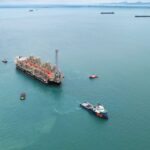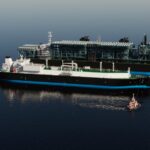Energy News Beat
Golar LNG said it continues to progress the company’s FLNG growth pipeline, while it is now in detailed commercial discussions to recharter its Hilli FLNG.
The LNG firm led by Tor Olav Trøim said in its third-quarter report that it continues to hold talks on recontracting Hilli upon the end of its current charter in July 2026 with a “number of counterparties and gas field owners”.
Golar said it is now in “detailed commercial discussions for three recontracting opportunities with a 2024 commitment targeted.”
The FLNG, located offshore Cameroon’s Kribi, recently offloaded its 100th cargo of liquefied natural gas since it started operations in 2018.
According to Golar, the unit unloaded its 102nd cargo on November 15, 2023, or more than 7 million tonnes of LNG up to date.
The floating LNG producer has in total four trains installed onboard with a production capacity of 2.4 mtpa.
Earlier this year, US LNG player New Fortress Energy sold its stake in the FLNG to Golar.
Golar acquired a 50 percent interest in trains 1 and 2 of the FLNG.
Besides this FLNG, Golar owns the 2.7 mtpa Gimi which will serve the first phase of BP’s Greater Tortue Ahmeyim FLNG project offshore Mauritania and Senegal under a 20-year contract.
This FLNG has just left Seatrium’s yard in Singapore and is on its way to the GTA hub site.
Golar expects the voyage to take around 60 days, including refueling stops in Mauritius prior to rounding the Cape of Good Hope and in Namibia prior to its arrival.
The firm said that commissioning is expected to take about six months from the commissioning start date with commercial operations (COD) expected thereafter.
This means that the commercial launch of the project could be achieved in the second or third quarter of 2024.
Golar and the GTA partners are “working on initiatives to further optimize the commissioning period in order to achieve COD as early as possible,” it said.
BP’s interim CEO Murray Auchincloss recently said the company is “hopeful” that it will launch the first phase of its Greater Tortue Ahmeyim FLNG project in the first quarter of 2024.
The company pushed back the start of the project due to a delay in the subsea scope.
BP also recently selected Swiss-based offshore contractor Allseas to complete the remaining subsea pipelay scope for the FLNG project, replacing previous contractor Houston-based McDermott.
US firm and project partner Kosmos said in its third-quarter report that the delivery of first gas from the first phase of the project has the potential to slip into the second quarter of 2024.
Golar said it continues to progress the company’s FLNG growth pipeline, including advancing commercial terms with gas resource owners, technical site-specific work, and governmental interaction and approvals across “several West African countries”.
“We are also seeing increasing interest for our market leading FLNG solution in other geographies, including the Americas,” it said.
Most of the projects under discussion are structures where Golar either participates as an equal partner with the gas resource owner and upstream partner in a gas field development, or commercial structures where Golar is exposed to gas offtake prices, it said.
“Golar’s market leading capex per ton and focus on proven gas reserves with attractive lifting costs in geographical areas with shorter shipping distances to end users versus US export projects secures a low break-even LNG production cost with attractive upside to current and forward LNG prices,” the firm said.
In August, Golar signed a heads of terms with Nigeria’s NNPC for joint development of gas fields using floating LNG producers, expanding on their deal signed in April this year.
The relevant fields could fully utilize FLNG Hilli following the end of its current contract in mid-2026, or utilize a MKII FLNG with an annual capacity of 3.5 mtpa, Golar previously said.
Earlier this year, Golar exercised its option to acquire the 148,000-cbm Moss-type carrier, Fuji LNG, which it aims to convert to a floating LNG producer.
The firm said that the cost of a converted Fuji FLNG is expected to be around $2 billion, equivalent to about $570 per ton.
“We continue to progress construction of long lead item orders for a MKII 3.5 mtpa FLNG project and expect to take delivery of the Fuji LNG carrier intended for FLNG conversion during Q1 2024,” Golar said in the third-quarter report.
The company said that engineering and detailed design is “fully developed and ready for project initiation.”
However, the complexity of offshore gas developments drives the timeline for these contemplated FLNG growth projects, it said.
“Until commitments on a gas field and secured debt financing are in place, we do not plan to take a final investment decision or incur significant incremental MKII FLNG capex beyond current committed levels,” the company said.
Golar also said in the report that its remaining LNG carrier, Golar Arctic, has completed a 12-month charter in September and its 5-year drydock in early November.
The 2003-built steam LNG carrier has a capacity of 140,000 cbm.
“Alternatives for this vessel including conversion projects, chartering, or sale are being considered,” Golar said.
The company also finalized the sale of the 1977-built LNG carrier, Gandria, for net consideration of $15.2 million.
Golar reported a net income of $114 million in the third quarter, and adjusted Ebitda of $75 million, inclusive of $39 million of non-cash items.
During the quarter, Golar repurchased 0.2 million shares at an average cost of $21.36 per share, leaving 105.9 million shares issued and outstanding as of September 30, 2023.
Golar’s board of directors approved a total third-quarter dividend of of $0.25 per share to be paid on or around December 11, 2023.
ENB Top News
ENB
Energy Dashboard
ENB Podcast
ENB Substack
The post Golar makes progress on FLNG plans appeared first on Energy News Beat.








